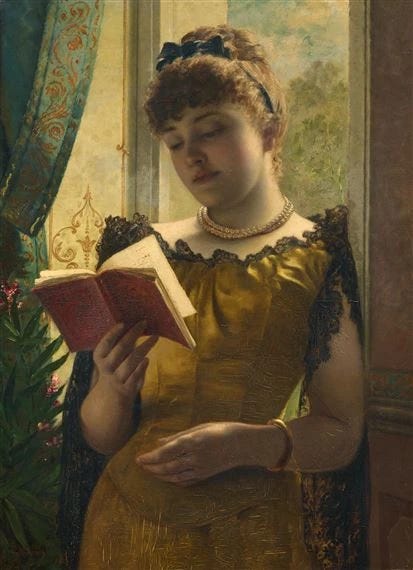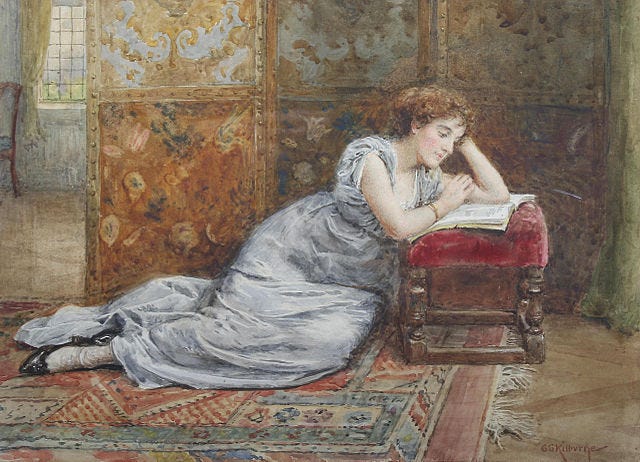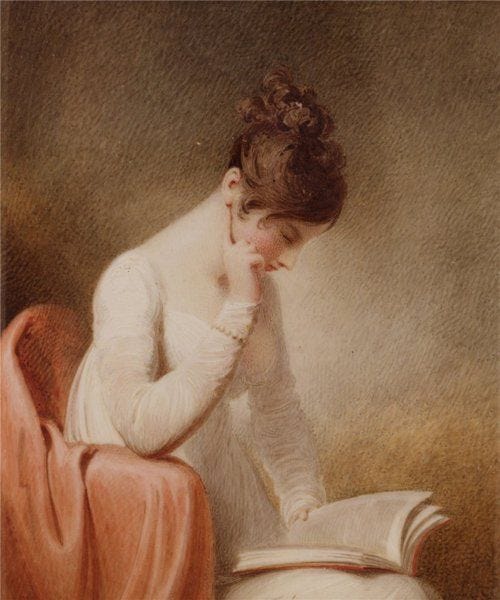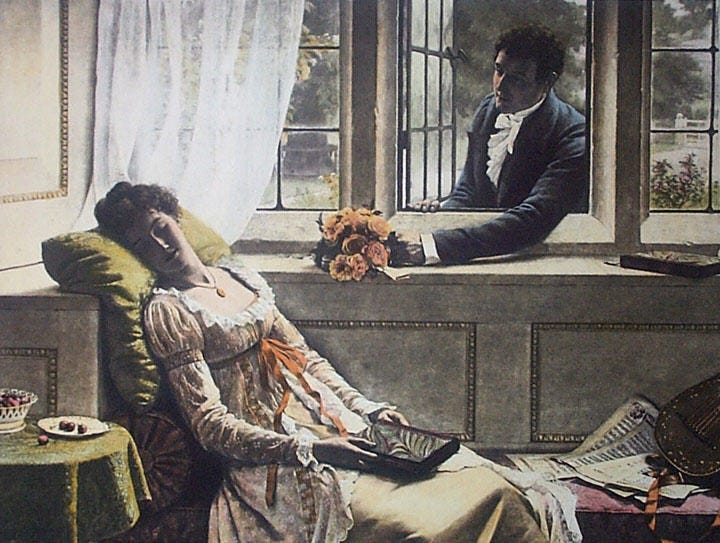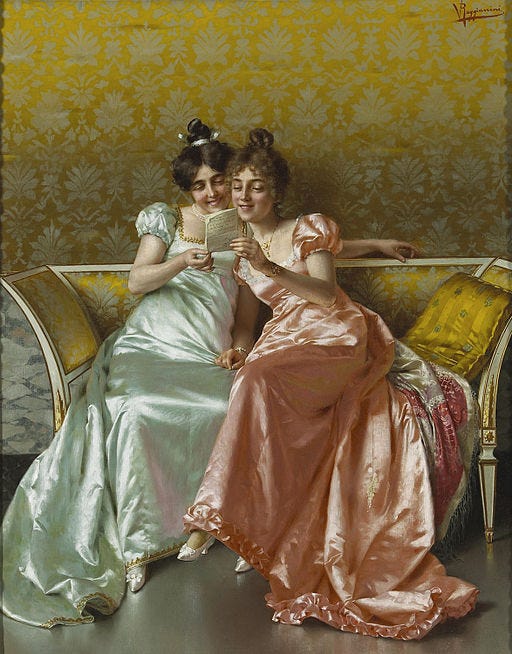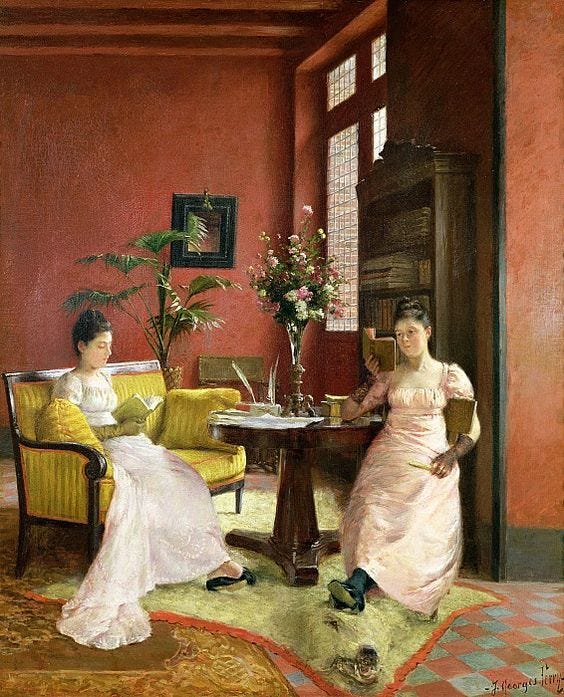Modern Austen's Guide to Reading Like a Woman in a Regency Painting
Reclaiming the image of a woman reading from the male gaze.
When Jane & Cassandra were schooled in the late 18th century, opportunities for female education were as narrow as the male artist’s depiction of women reading in their work. The Austen sisters attended schools briefly but were eventually taught privately at home by their father, Reverend George Austen, where Professor Kathryn Sutherland believes they “benefitted from their father’s library & from his informal instruction.” Jane would have been aware of the debate over the purpose of a woman’s education happening among writers like Mary Wollstonecraft & Catharine Macaulay, who believed that a woman should have the opportunity to learn more than what was prescribed for attracting a husband (a bit of French & Italian, drawing skills, & musical talent).
Austen takes up this debate in all her novels, according to Professor Sutherland, making the case that there’s an “intellectual & moral distance between the show of mere accomplishment & the deeper understanding that signals self-knowledge.” To Jane, the accomplishments allowed women were ornamental compared to the substance of knowing one’s self. “All her heroines are keenly aware of their deficiencies in education [perhaps none more than Lizzie Bennet],” Sutherland writes; for some, particularly Anne Elliot, reading was a “route to such inward knowledge.” It was Jane’s belief that novels can teach heroines how to read the people & world around them, how to be in society. This is also what makes women reading so “dangerous.”
“All her heroines are keenly aware of their deficiencies in education.”
The patriarchal society of Jane Austen’s time didn’t want books telling women how to be in the world. The fear of how people interpret what they read is about as old as the written word itself, or at least as “ageless [as the] fear men have of what women might do in the secret places of their body,” writes Alberto Manguel in his A History of Reading (1996). Equating the male fear of women reading with their fear of women attaining sexual pleasure (especially without them) isn’t a ridiculous connection to make. After all, literary theorist & philosopher Roland Barthes claims there’s a kind of eroticism inherent in the act of reading, & any good reader has experienced the feeling of a book holding or touching her. The sight of a woman reading, to a man, is the sight of a woman enacting “irrepressible autonomy,” James Conlon (2005) writes in his paper on the images of women reading in art.
Reading is an act of interpretation that cannot be controlled or dictated even by the text; the reader can read “with either a submissive or subversive eye” (Conlon, 2005, p. 40). So, when faced with the image of a reading woman, a man might feel threatened, might feel the need to assert his dominance over any knowledge she acquires. Conlon believes this need for dominance is why so many male artists have been drawn to the image of a reading woman: “What is surprising, especially considering the limited access women have had to literacy throughout history, is the number of images of women reading” (37). They’re drawn to the image because they want to control it, placing it in the conventional, domestic world where women rely on men. Many paintings of Regency women reading show them posing rather than sitting on chairs or sofas, engaged in reading that’s more light-hearted than reflective. These bookish women are aware they’re being observed by the male gaze, which is who male artists were painting these images for.
“What is surprising, especially considering the limited access women have had to literacy throughout history, is the number of images of women reading.”
In paintings of men reading, Conlon points out, “the book is a sign of his profession or his wisdom” (46). For women, the book is a distraction, a dalliance, something to help pass the time. These paintings focus on the peaceful interior settings, not the reflection & self-knowledge Austen argues come from reading. From the man’s view, a reading woman should have has no agency.
Perhaps these paintings are ready for new readings & interpretations. “Let us no longer interpret historic depictions of women reading as peaceful, mundane scenes,” Gianna Scavo writes for Art UK, “but as glimpses into treasured, private moments, in which ideas & the imagination were allowed to roam freely.”
“Let us no longer interpret historic depictions of women reading as peaceful, mundane scenes, but as glimpses into treasured, private moments, in which ideas & imagination were allowed to roam freely.”
Here’s your guide to reading like a woman in a Regency painting, as seen through a modern heroine gaze.
Find the room that gets the best natural light
What’s the point of reading if you & your book can’t look good doing it? Hold your book at an angle & position yourself to let the light hit you in a most picturesque manner.
Try to get your nose in the book
Read the smallest book you can possibly find so that you have no choice but to stick your face in it.
Always have something to lean on
Preferably a wall near a window, & in full view of someone whose attention you wouldn’t mind grabbing.
Get comfortable
No need to strain your neck while you strain your eyes to finish a novel.
Read something amusing
It’s best not to take reading for self-improvement too seriously.
Use your lap as a book stand
If sitting with your head tilted down is a reading position that works for you.
Pretend reading exhausts you
Especially when there’s a pesky suitor at the window.
Read with friends
To frighten men into thinking all women are conspiring against them.
Be anti-social with books
Bond over books, not gossip.
Look someone in the eye when they make you lose your place
There’s no excuse for disturbing a woman with a book!





